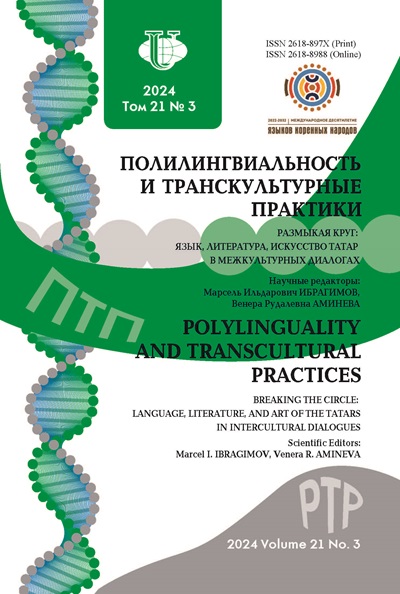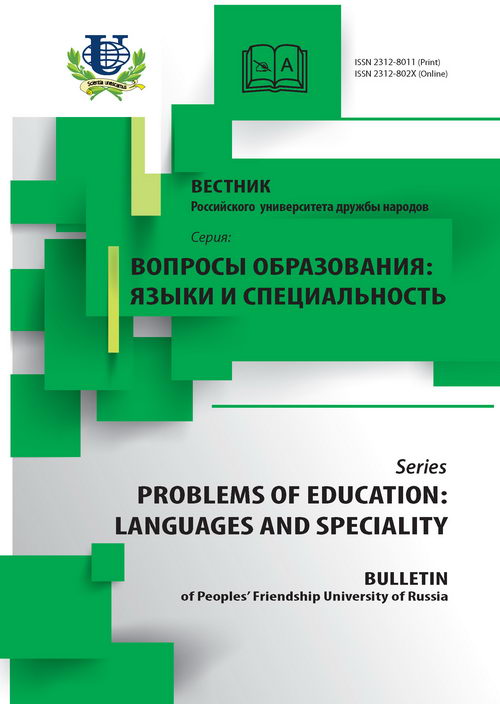No 2 (2016)
Articles
RUSSIAN LANGUAGE AND SPACE. TRAINING INTERNATIONAL SPACE CREWS: AIMS, TARGETS, PROSPECTS
Abstract
Developing optimal methods of Russian language training for astronauts who view the Russian language as a tool of professional and educational training is connected with a wide range of linguistic and didactic features. The teaching process is conducted with a view to form skills and abilities of rational verbal behavior in different situations of professional communication during a pre-flight training as well as in the space orbit. Mastering the Russian language is a very important factor for foreign astronauts since it leads to acquisition of special competence and professional knowledge in Russian.
Polylinguality and Transcultural Practices. 2016;(2):9-16
 9-16
9-16


K YuBILEYu NATAL'I VLADIMIROVNY UFIMTsEVOY
Polylinguality and Transcultural Practices. 2016;(2):17-19
 17-19
17-19


COMPARATIVE ANALYSIS OF FRAGMENTS OF RUSSIAN AND ITALIAN LANGUAGE CONSCIOUSNESS
Abstract
The article presents the first results of the free associative experiment and examines the problem of interlingual equivalence between some stimulus words. We analyze the associative fields of the language units under consideration to reveal the similarities and differences between the images of Russian and Italian language consciousness. The results illustrate some peculiarities of the world image reflected in the consciousness of Italians and Russians.
Polylinguality and Transcultural Practices. 2016;(2):20-26
 20-26
20-26


THE REFLECTION OF THE SPECIFICITY OF LANGUAGE CONSCIOUSNESS OF AN ETHNIC GROUP IN THE MATERIALOF FREE ASSOCIATIVE EXPERIMENT: INTERCULTURAL ASPECTS
Abstract
The article deals with the relevance of research of the peculiarities of linguistic consciousness (LC) of an ethnic group from the positions of psycholinguistic theory of intercultural communication as a new ontology of the analysis of LC. The aim of the investigation is the search of the ethnic identity of an ethnos, on the basis of which goals to identify elements of a community and ethno-cultural specificity of the language consciousness of contacting ethnics groups are set. The associative dictionaries of the Russian and Kazakh languages which reflected linguistic consciousness of the compared linguocultural communities, having been contacting with each other for a long time were used as research materials.Identified similarities in the process of comparison of associations to the same word stimuli may indicate the inevitable generality of the ethical, moral, family and kinship relations due to the basic human values, on which the human society is formed and kept.On the other hand, the differences and divergent strategies of the association are subject to the national and cultural peculiarity of the life of an ethnos, its traditions and customs. It itself is interesting from a historical, social and cultural points of view and may not necessarily lead to misunderstanding and cultural conflicts. This diversity and “otherness” may contain special heuristic potential, be a source of research interests, the reason for the attraction of ethnic groups to each other and a search for inter-ethnic tolerance.
Polylinguality and Transcultural Practices. 2016;(2):27-37
 27-37
27-37


HOMONYMS IN FOREIGN AND RUSSIAN DICTIONARIES OF THE ENGLISH LANGUAGE(based on the homonym ‘lie’)
Abstract
The article analyses various ways of representing homonyms in different types of dictionaries of the English language (bilingual and monolingual). The author considers the influence of these representative methods on students’ perception of homonyms; studies various structures of dictionaries and reveals the lack of integrity in representation of homonyms regardless of the type of a dictionary (English- English or English-Russian) and its intent (educational or explanatory). The carried out experiments (free associative experiment; insertion of homonyms in a context) with high school students in a school with advanced study of English showed that even pupils who are good at a foreign language often don’t distinguish homonymy from phenomena related to it, such as polysemy.
Polylinguality and Transcultural Practices. 2016;(2):38-47
 38-47
38-47


TYPOLOGY OF DERIVATIONAL PROCESSES IN THE FAMILIES OF EQUIVALENTS OF ABRIDGED WORDS
Abstract
In this paper the author describes the derivational processes found in the families of equivalence in the abbreviation group “auto” in the Russian language. On the basis of three approaches of comparison of the family units (quantitative, semantic and onomasiologic) there are six kinds of such processes (univerbalisation, modification, pseudouniverbalisation, compression and secondary abbreviation).
Polylinguality and Transcultural Practices. 2016;(2):48-54
 48-54
48-54


ANTROPOCENTRIC APPROACH TO TEACHING FOREIGN LANGUAGES TO POSTGRADUATE STUDENTS
Abstract
The implementation of the anthropocentric approach to teaching foreign languages to postgraduate students is viewed as the formation of linguistic identity possessing professional foreign language communicative competence and capable of providing cross-cultural communication in the scientific community. Learning model is determined: goals, objectives, structure, content, forms of control.
Polylinguality and Transcultural Practices. 2016;(2):55-63
 55-63
55-63


METHODOLOGY OF STILISTICS LEARNING IN THE SYSTEM OF SCHOOL EDUCATION OF REPABLIC OF BELARUS:NEW APPROACHES
Abstract
Modern methods of stylistic teaching are generalizations of teaching experience in the traditional style, developed by V.V. Vinogradov, and modern approaches, which include cognitive stylistics. The article shows the necessity of introducing the elements of cognitive stylistics into school curriculum in stylistics of the Russian language. It allows to see the connection between the stylistic nature of language and basic cognitive processes, it teaches techniques and shows their role in oral communication. One of these techniques can be considered the foregrounding, with the particularly important part of the message in the foreground, that is very important for the processes of understanding and interpretation of messages (text).
Polylinguality and Transcultural Practices. 2016;(2):64-70
 64-70
64-70


MULTIMEDIA EDUCATIONAL RESOURCES AS MEANS OF MAINTENANCE OF LANGUAGE AND CULTURE
Abstract
The article states the risk of loss of the younger generation of the Russian language wealth and cultural heritage. This is due, in particular, with a small number of educational multimedia Internet resources for the study of Russian language and culture, and therefore attractive for young people. The idea of creating a multimedia textbook for young Internet users, providing information about the facts of Russian culture and their reflection in language, has become the main for the authors of multimedia dictionary of language and culture “Russia”. The main content of the article is a summary of the vocabulary concepts and description of the possibilities of its use in the practice of learning and teaching of the Russian language (vocabulary, information articles, media library, interactive exercises).
Polylinguality and Transcultural Practices. 2016;(2):71-77
 71-77
71-77


THE APPROACHES TO MEASURING MATERIALS IN ADDITIONAL PROFESSIONAL PROGRAMMS OF SOCIAL AND HUMANITARIAN SUBJECT AREA
Abstract
The central task of the author of the article was to analyse the forms of appraisal and evaluation materials presented in the training programmes of social and humanitarian subject areas. institutions implementing vocational further education of pedagogical workers in the city of Moscow. These programmes are submitted by institutions that implement additional professional education of teachers in Moscow. It was made random sampling of training programmes of social and humanitarian subject areas from the existing data base on the institutions that implement additional professional education of teachers in Moscow. They were developed the criteria of analysis of the forms of certification and assessment materials presented in the programmes. Further, based on the proposed criteria analysis of training programmes was held proper. The article presents the results of analysis in visual form, produces statistical processing of the results of the analysis. In the end, we have formulated a scientific and practical conclusions on the feasibility to be used in the practice of additional professional education forms and controls. In the future we will make detailed recommendations for improving the system of control for the continuation of research work.
Polylinguality and Transcultural Practices. 2016;(2):78-89
 78-89
78-89


LEO TOLSTOY: A CONSERVATIVE INNOVATOR IN TRANSCULTURAL ENGLISH CONTEXT
Abstract
The oxymoronic combination “conservative innovator” attempts to describe the coexistence of converse attitudes in Tolstoy’s philosophy and aesthetics, which determined, among other things, his reception in the world. The analysis of recent English studies leads to a conclusion on the direct link between Tolstoy’s quests and modernity as well as on the special significance of his heritage for understanding transcultural dialogue in the present century.
Polylinguality and Transcultural Practices. 2016;(2):90-97
 90-97
90-97


A LOOSE TRANSLATION: TO THE PROBLEM OF LINGUO-CULTURAL ACCOMODATION OF RUSSIAN POETRY(on the Material of English-Language Translations of B. Okudzhava’s poems)
Abstract
The article is concerned with loose translations in the context of linguo-stylistics and intercultural communication. It provides definitions of the term “a loose translation” and a step-by-step comparative stylistic analysis of two poems by B. Okudzhava and their English-language equivalents. The comparative analysis of their semantics, rhythmo-metric characteristics, rhymes and vocabulary outlines the main features of a loose translation: the adequacy ratio of not lower than 20%, a system of maintained semantic connections with the original, a relatively high artistic value of the translation itself. The identified features enable to mark this type of translation very high in the hierarchy of poetic translation typology and recognize its significant role in an adequate dialoguing of intercultural communicants.
Polylinguality and Transcultural Practices. 2016;(2):98-104
 98-104
98-104


THE STRUCTURE AND SOCIOPRAGMATICAL POTENTIAL OF NOMINATIVE ROWS IN THE CREATIVE WORKS BYV.P. ASTAFJEV AND H. BÖLL: THE COMMON AND PECULIAR FEATURES
Abstract
The problem of functioning of characters’ nominative rows in literary works within modern scientific paradigm is characterized by fractional theoretical description and the necessity of new applied approaches in the presentation and description of the material as well as development of sociopragmatic ways in the study of literary anthroponyms. Male and female nominative rows presented in the works by V.P. Astafjev and H. Bӧll are described in the article in the comparative way. Their length, structural, sociosemiotic, linguistic and pragmatic specificity are defined. It is proved that the textual significance and the frequency of the nominative row are directly proportional.
Polylinguality and Transcultural Practices. 2016;(2):105-112
 105-112
105-112


INTERNATIONAL SCIENTIFIC CONFERENCE “REGIONAL ONOMASTICS: PROBLEMS AND PERSPECTIVES OF RESEARCH”
Polylinguality and Transcultural Practices. 2016;(2):113-119
 113-119
113-119


THE LANGUAGE OF HOSPITALITY: INTERNATIONAL CONFERENCE«DEVELOPMENT OF COMPETENCES FOR HOSPITALITY INDUSTRY IN UNIVERSITY ENVIRONMENT» MOSCOW, 22ND JANUARY, 2016
Polylinguality and Transcultural Practices. 2016;(2):120-124
 120-124
120-124


NAShI AVTORY
Polylinguality and Transcultural Practices. 2016;(2):125-126
 125-126
125-126















